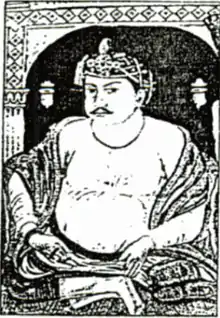| Bakht Buland Shah | |
|---|---|
| Raja | |
 | |
| King of Nagpur | |
| Reign | 1686-1706 |
| Predecessor | Kok Shah (1620-1660) |
| Successor | Chand Sultan (1706-1739) |
| Born | Bhagtu[1] |
| Burial | |
| Issue | Chand Sultan, Mohammad Shah, Ali Shah, Yusuf Shah, Wali Shah[4] |
| House | Gonds of Deogarh |
| Dynasty | Rajgond |
| Father | Gorakh Shah[5] |
| Religion | Islam |

Bakht Buland Shah was a ruler of the Rajgond dynasty. He added to his kingdom, the territories of Chanda and Mandla, and portions of Nagpur, Balaghat, Seoni, Bhandara and the adjoining Rajput kingdom of Kherla/Khedla.[6] The present districts of Chhindwara and Betul also fell under his control. A great warrior, he went on to conquer Pauni, Dongartal, Sivni, and Katangi.[7][8]
Ascension to the throne
Bakht Buland's initial name was Bhagtu.[9][1] After his father Kok Shah's death, a war of succession broke out. He was the younger son of Gorakh Shah, the Gond ruler of Deogarh.[5] To regain his throne from his brother, Bakht Buland went to Mughal capital of Delhi in 1686 and reluctantly accepted Islam, in order to get military assistance from the Mughal emperor Aurangzeb.[10][7] In exchange, he was recognized as the Raja of Deogarh.[7] With Aurangzeb's help, he was firmly established as the ruler of Deogarh in 1686.[9]
Reign
Bakht Buland Shah later rebelled against the Mughals in 1700 and snatched portions of their territory, when the empire had grown weak due to the long Mughal war against the Marathas.[7][11] He even plundered the Mughal territory[7] on both sides of the Wardha river.[12] Thus he earned the disfavour of Aurangzeb, who thereupon ordered that the title "Bakht Buland" (lit. 'of high fortune') should be changed to "Nigun Bakht" (lit. 'of mean fortune'). Nothing is known of the army sent to punish Bakht.[8]
He was ceded the district of Seoni, Chauri, Dongartal, and Ghansour[12] by Narendra Shah of Mandla for his aid against the rebellious Pathan jagirdars in the Garha Kingdom.[13][14] He also added parts of the Chanda Kingdom to his domain.[15] His kingdom included the present-day districts of Chhindwara, Betul, Balaghat, Sivni (Seoni), and Bhandara.[16]
He is chiefly remembered for founding the present settlement of Nagpur city.[15] Bakht Buland Shah founded the city of Nagpur in 1702 by joining the twelve hamlets formerly known as Rajapur Barsa or Barasta.[17][4] He built roads and a strong wall around the city.[16][18][19]
According to Sir Richard Jenkins, "He indiscriminately employed Musalmans and Hindus of ability to introduce order and regularity into his immediate domain. Industrious settlers from all quarters were attracted to Gondwana, thousands of villages were founded, and agriculture, manufacture and even commerce made considerable advances. It may be said that much of the success of the Maratha administration was owing to the groundwork established by him."[7]
He died in about 1706 and was succeeded by his elder son Chand Sultan.[8][4]
References
- 1 2 Bulletin of the Anthropological Survey of India. Director, Anthropological Survey of India, Indian Museum. 1976.
- ↑ Chakraborty, Proshun (5 December 2014). Scrap dealer holds key to entry into Bakht Buland Shah's grave | Nagpur News.
{{cite book}}:|newspaper=ignored (help) - ↑ "राजे बख्त बुलंद शाह समाधीस्थळ विकासाचा प्रस्ताव पडून". Lokmat (in Marathi). 7 March 2021.
- 1 2 3 Alavi, Shams Ur Rehman. "Bakht Buland Shah: Ruler who founded Nagpur and whose dynasty ruled in Vidarbha, parts of Madhya Pradesh".
- 1 2 Deshpande, Y. K. (1950). "Fresh Light on the History of the Gond Rajas of Deogarh". Proceedings of the Indian History Congress. 13: 231–233. JSTOR 44140920.
- ↑ Maharashtra State Gazetteers: Bhandara. Director of Government Printing, Stationery and Publications, Maharashtra State. 1979.
- 1 2 3 4 5 6 Kurup, Ayyappan Madhava (1986). Continuity and Change in a Little Community. Concept Publishing Company.
- 1 2 3 Medieval PERIOD (Complete History of Nagpur). 16 July 2021.
- 1 2 Bahadur), Sarat Chandra Roy (Rai (1979). Man in India. A. K. Bose.
- ↑ Pradesh (India), Madhya (1992). Madhya Pradesh: Balaghat. Government Central Press.
- ↑ "Gond King". Archived from the original on 31 May 2014.
- 1 2 Sil, Jogendra Nath (1917). History of the Central Provinces and Berar. J.N. Sil.
- ↑ ed. Sil, Jogendra Nath, History of the Central Provinces and Berar, 1917
- ↑ Maharashtra State District Gazetteers: Bhandara. 2013.
- 1 2 Society (MANCHESTER), Northern Central British India (1840). Proceedings of a Public Meeting for the formation of The Northern Central British India Society held in the Corn Exchange, Manchester, on Wednesday evening, August 26th, 1840. Northern Central British India Society.
- 1 2 Deogaonkar, Shashishekhar Gopal (2007). The Gonds of Vidarbha. Concept Publishing Company. ISBN 978-81-8069-474-5.
- ↑ Naik, C. D. (2010). Buddhism and Dalits: Social Philosophy and Traditions. Gyan Publishing House. ISBN 978-81-7835-792-8.
- ↑ Baum, Tom; Butler, Richard (4 August 2014). Tourism and Cricket: Travels to the Boundary. Channel View Publications. ISBN 978-1-84541-453-5.
- ↑ Rashkow, Ezra; Ghosh, Sanjukta; Chakrabarti, Upal (18 August 2017). Memory, Identity and the Colonial Encounter in India: Essays in Honour of Peter Robb. Taylor & Francis. ISBN 978-1-351-59694-7.